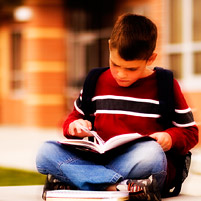Leading Autism Research

The Centers for Disease Control and Prevention estimate that one in 88 U.S. children have autism spectrum disorders.
Through hard work and dedication, our Carnegie Mellon University experts — such as Marcel Just, Justine Cassell and Marlene Behrmann — are getting closer every day to unraveling the unknown of this complex developmental disability.
For decades, CMU has been a leader in the areas of brain science, psychology, and learning research. And as part of the university's brain, mind and learning initiative, we are becoming an even more prominent player in these fields.
New research from Just, for example, provides an explanation for some of autism's mysteries, giving scientists clear targets for developing intervention and treatment therapies.
Published in the journal "Neuroscience and Biobehavioral Reviews," Just and his team used brain imaging and computer modeling to show how the brain's white matter tracts — the cabling that connects separated brain areas — are altered in autism and how these alterations can affect brain function and behavior.
"White matter is the unsung hero of the human brain," said Just, the D.O. Hebb Professor of Psychology within CMU's Dietrich College of Humanities and Social Sciences and director of the university's Center for Cognitive Brain Imaging (CCBI). "In autistic individuals, we can measure the quality of the white matter, and our computer model can predict how coordinated their brain activity will be. This gives us a precise account of the underlying alterations affecting autistic thought."
Cassell is the Charles M. Geschke Director of the Human-Computer Interaction Institute (HCII) at CMU and regarded as one of the field's leading innovators.
"One of the projects I'm working on concerns children with autism — in particular, children with Asperger's syndrome, or high-functioning autism, who are often very smart and very interested in computers and technology but who may have less of an ability to interact with other people," Cassell explained.
Cassell is researching a way for computers to link those children to the social world. There are many benefits to friendship - to interpersonal connection — and modeling the use of language for children with Aspergers to make and maintain relationships may prove valuable.
In a recent imaging study of sleeping toddlers, Behrmann and her researchers found some to have a diminished ability of the two brain hemispheres to "sync" with one another.
The discovery could be a powerful new biological marker of autism — one that could soon enable an autism diagnosis at a very young age.
"With this study, we have made significant scientific progress in understanding autism at the genetic, behavioral and neurobiological levels," said Behrmann said.
"This work is one piece of a complicated puzzle as we try to identify and characterize potential biological markers. We hope to connect this work with geneticists to develop concrete descriptors as well as determining if the markers will predict different autistic patterns as children grow up."
Conquering autism is not only on the minds of CMU researchers but also our students and graduates. The research of Marek Michalowski, who earned his Ph.D. at CMU, is calling into question longstanding theories of the disease.
Since Michalowski "taught" the soft rubber peep of a robot named Keepon how to dance in 2003, Keepon has demonstrated an ability to charm its way into the lives of severely autistic children who have responded to the five-inch-tall robot with emotion they rarely show to their own parents.
Related Links: Brain, Mind & Learning | Genetics and Autism | Keepon: Dancing with a Star | Dietrich College | HCII | Robotics Institute
